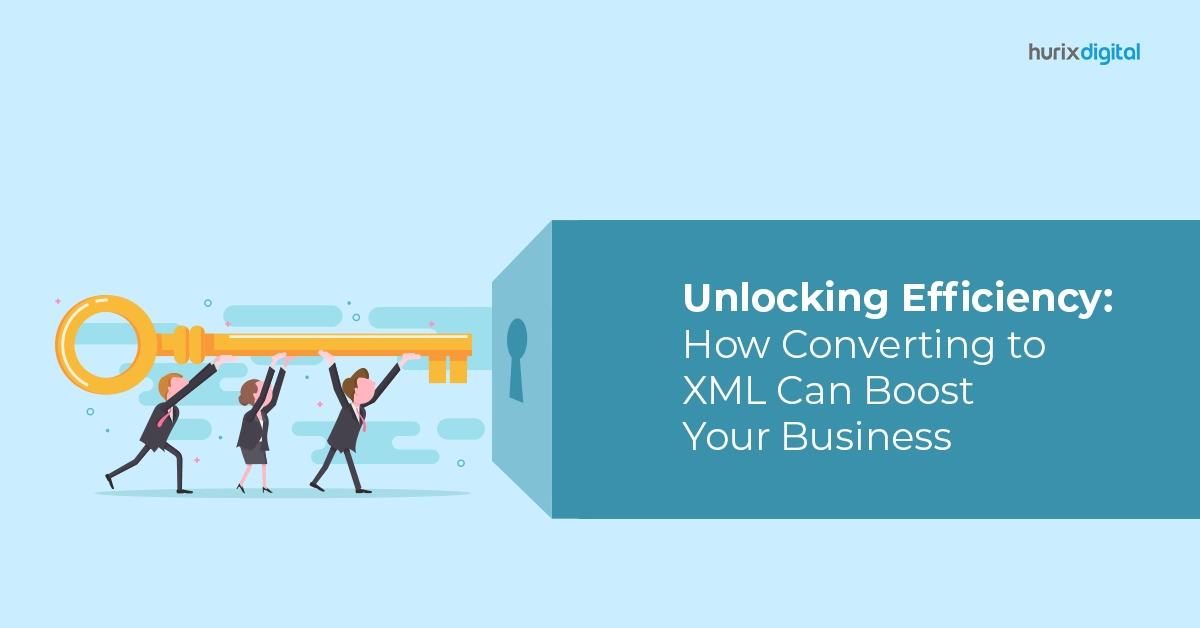
Unlocking Efficiency: How Converting to XML Can Boost Your Business?
Summary
Discover how converting to XML can enhance business efficiency. This article provides insights into the benefits and processes of XML conversion.
Organizations may find it challenging to deal with the ever-growing volume of data. Conventional data formats can impede seamless exchange and foster data silos, complicating the extraction of meaningful insights. Extensible Markup Language (XML) or an XML converter, in this regard, offers a solution and streamlines the data management process.
XML serves as a structured framework for organizing data, catering to both human comprehension and machine processing. This way, it facilitates seamless data exchange and interoperability across various systems and applications.
Table of Contents:
- Understanding XML Converters
- The Impact of XML Conversion
- How Can XML Conversions Boost Your Business?
- XML Converter Selection
- Best Practices for Long-Term Success
- Conclusion
Understanding XML Converters
An XML converter is software that transforms data from one format to the Extensible Markup Language (XML).
Think of it as a translator designed explicitly for the language of structured data. Your existing information, stored in formats like print and digital formats, spreadsheets, or databases, is converted into XML with the help of an XML converter.
XML converters analyze your data and identify its structure and meaning. Then, they apply predefined rules and tags outlined by the XML standard to represent that information in a structured manner.
This process involves:
- Assigning designated tags to each piece of information to ensure clarity and organization.
- Encompassing specific data details, such as author and date, within the tags for comprehensive understanding.
- Adhering to established rules to ensure seamless compatibility and interoperability with other XML-based systems.
Also Read: Unleashing the Power of XML Conversion in Data Management
The Impact of XML Conversion
XML bridges the gap between human-readable and machine-understandable data.
Here’s what makes it a game-changer:
- XML allows for smooth exchange between a wide range of systems and applications. Regardless of platforms or vendors, XML enables efficient data transfer.
- XML’s adaptable structure makes it easy to handle increasing data volumes, making it excellent for managing vast and complicated datasets.
- Structured data in XML conversion makes searching, filtering, and analysis easy, resulting in significant insights. Consider adding keywords and tags to documents so that they can be easily searched in a library catalog.
- XML’s validation capabilities ensure data integrity by enforcing stated rules and eliminating discrepancies. This lowers the inaccuracies and redundancies that characterize unstructured data.
- The widespread usage of XML across businesses allows for smooth information transmission. This facilitates collaboration and streamlines business processes worldwide.
How Can XML Conversions Boost Your Business?
XML’s scope spans across different corporate operations, increasing productivity in areas such as:
- Data Interchange: Effective data interchange across diverse systems is critical. XML simplifies this and improves global interchange.
- Content Management System (CMS): Structured data in an XML converter enables CMS platforms to reuse content and boost SEO by increasing content discoverability.
- E-commerce Platforms: XML is essential in e-commerce because it enables efficient data sharing. It helps with product information management, simplified order processing, and individualized consumer experiences.
- Automation of Structured Data: XML conversion automates repetitive tasks, liberating human resources for strategic endeavors and fostering operational agility.
- Validation for Data Accuracy: XML’s validation capabilities mitigate data errors and inconsistencies, ensuring information integrity for informed decision-making.
- Enhanced Collaboration: Smooth XML-based data interchange fosters effective collaboration among departments and facilitates seamless communication with external partners.
- Elevated Staff Productivity: Streamlined workflows and reduced errors translate into heightened staff productivity, driving business momentum.
- Accelerated Launches and Rollouts: Efficient XML-based data processing expedites product launches and service rollouts, enabling swift market entry.
- Enhanced Customer Service: Improved data accuracy resulting from XML conversions translates into superior customer service experiences, fostering loyalty and satisfaction.
XML Converter Selection
Here are the steps to select an XML converter:
- Begin by understanding your organization’s specific requirements in terms of data volume and conversion complexity. Conduct thorough research to identify XML converters that align with these needs.
- As your business grows, so will your data requirements. Choose an XML converter that offers scalability, allowing you to seamlessly accommodate increasing volumes of data without compromising performance.
- Opt for a user-friendly XML converter that simplifies the conversion process and minimizes the learning curve for your team. Intuitive interfaces and comprehensive documentation can significantly enhance usability and efficiency.
- Look for XML converters that offer automation capabilities, allowing you to streamline repetitive tasks and reduce manual intervention. APIs (Application Programming Interfaces) and data integration tools can further enhance automation and facilitate seamless data transfer between systems.
- While considering various XML converter options, evaluate their overall cost-effectiveness, taking into account factors such as licensing fees, implementation costs, and potential savings from increased efficiency and productivity.
By following these steps and considering key factors such as scalability, compatibility, and automation capabilities, you can confidently select an XML converter that aligns with your organization’s objectives and empowers you to utilize the full potential of XML technology.
Best Practices for Long-Term Success
To ensure the longevity and effectiveness of your XML conversion efforts, consider the following best practices:
- Encourage open communication and collaboration across departments involved in data management and consumption.
- Encourage a shared knowledge of XML’s benefits to increase user buy-in.
- Actively seek user input to discover areas for improvement in your XML implementation.
- Maintain a culture of constant iteration, enhancing procedures, and responding to changing data requirements.
- Create systems to collect user feedback, such as surveys or focus groups.
- Analyze and utilize the feedback to improve the global interchange of XML implementation strategies and address any issues.
- Remain flexible and adaptable in response to evolving business requirements, technological advancements, and regulatory changes. Anticipate future needs and proactively adjust XML conversion strategies and workflows accordingly to stay ahead of the curve.
Following these strategic steps and best practices will ensure a successful XML conversion installation that maximizes the value of structured data for your business.
Check out EXCLUSIVE: HurixDigital Converts XML Files to HTML and Publishes 250,000 Backlist Titles
Conclusion
To step into a data-driven future, effective data management is crucial, and XML is a powerful tool for businesses. Implementing XML requires a structured approach. Start by assessing your current data situation, then craft a transfer plan, and finally, choose the right XML converter.
The route to a data-driven future begins with effective data management. Businesses profit greatly from implementing XML.
At Hurix Digital, we stand ready to accompany you every step of the way on your XML conversion journey. From facilitating seamless data conversion to imparting integration knowledge and providing ongoing assistance, we are committed to empowering you to harness the full potential of XML technology.
Connect with us today to explore the benefits of effective data management!

Vice President – Content Transformation at HurixDigital, based in Chennai. With nearly 20 years in digital content, he leads large-scale transformation and accessibility initiatives. A frequent presenter (e.g., London Book Fair 2025), Gokulnath drives AI-powered publishing solutions and inclusive content strategies for global clients




